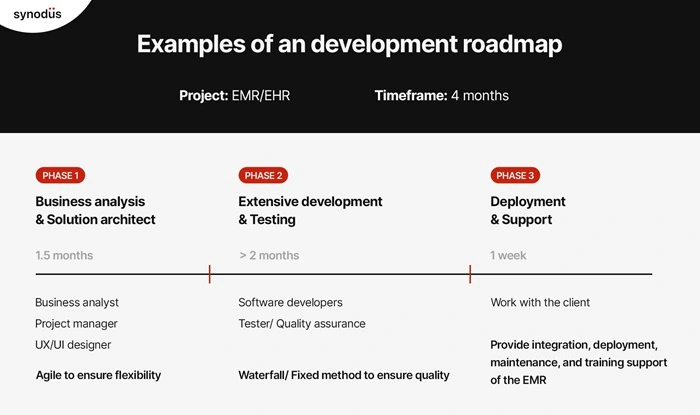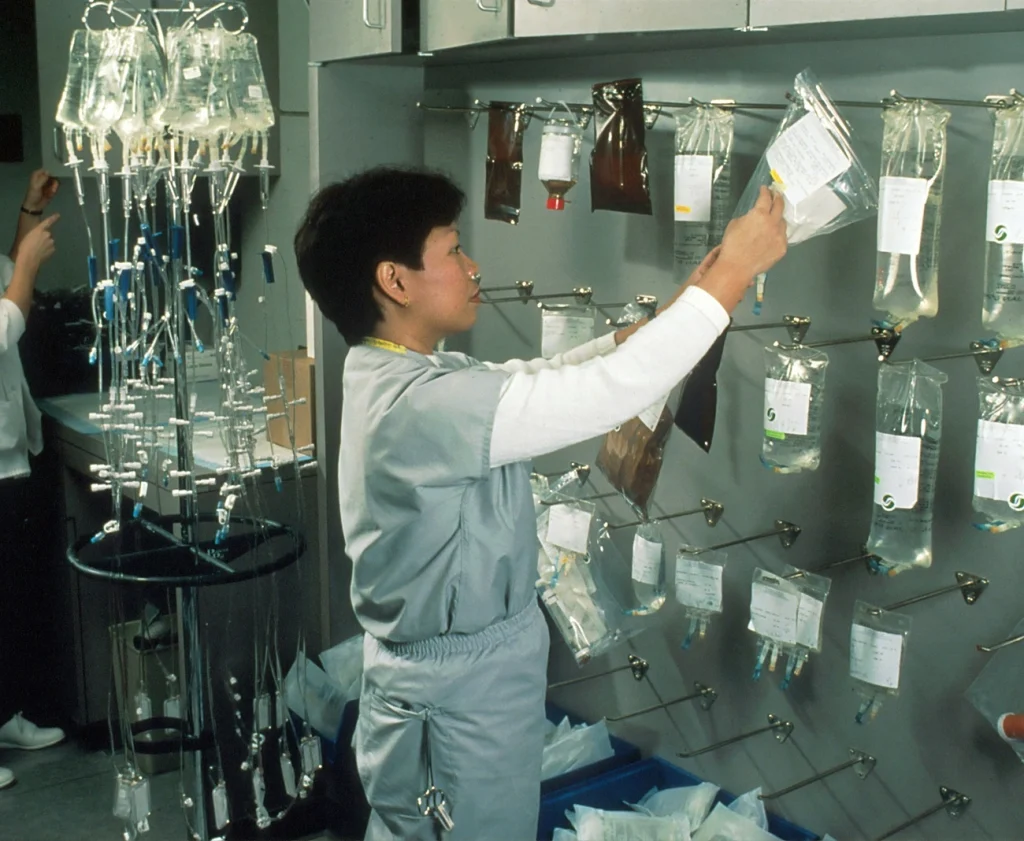In this article, you will:
- A detailed explanation of a real-life EMR implementation, including the challenge, the solution, and the result.
- Learn the way that makes this EMR case study a success.
- How to choose the right EMR/EHR development partner (if you need one)
- Learn what to avoid when customizing and deploying an EMR/EHR.
Breaking down an EMR case study that decreases 90% of incident rates
Project overview
| Services used | Team size | Timeframe | Solution |
|---|---|---|---|
| Custom software development Dedicated team | 6 members | 4 months | Packaged Cloud-based Mobile app |
Not only is this hospital among the largest multi-field medical complexes in their region, but it is also one of the top two centers for laparoscopic common bile duct surgery. Despite having qualified and experienced doctors and experts, the facility failed to deliver a seamless hospital visit and faced low patient satisfaction.
They wished to change, and one of the strategies was to become paperless with EMR.
Paper-based process, internal mess
Managing 700 beds and 2,500 outpatients daily, the facility needs to access, transmit, and handle a vast amount of data. However, with an outdated system, all 800 staff struggled to maintain the pace, leaving patients no choice but to wait.
There is nothing worse than a bad health check experience. Patients were frustrated, doctors were tired, and the process remained a headache. Not to mention, this inefficient and lengthy communication also dismissed the quality and hard work of many staff.

During their search for a suitable EMR, our client came to the decision of customization, since no SaaS system can adapt to their requirements:
- The staff can flexibly change the records template and search filtering when needed.
- The EMR should be integrated with a hospital information system (HIS), appointment scheduling, mobile app for patients, performance analytic dashboard, and inventory management.
- Adaptive to their local regulatory standard on data governance and healthcare protection, alongside HL7 and HIPAA.
- A balance between cost and quality.
Currently in the search like our client once was?
Our process of tailoring an EMR
The most challenging part of the project scope isn’t the flexibility or scalability but how to check out all the high-level requests with a cost-effective approach.
Here’s what we did:
- We use a packaged EMR – a set of fundamental features that they can immediately use for the facility. From there, we cut down time during development and optimize our client’s spending.
- To ensure flexibility, we added customization to build advanced features, adapting to our client’s corner case.
- We implement a hybrid model of agile and fixed cost. During the first few phases of business analysis, solution architecture, and design, we use agile to help our client flexibly sort out their requirements. After getting everything set, we move to a fixed phase of extensive coding and testing. By combining these opposite approaches, we give the client space to customize while ensuring time and cost efficiency.
With a clear development roadmap, our team of Business analysts, Project managers, Developers, and Testers/ QAs quickly completed the customed EMR under four months before the estimated deadline.

What the EMR can do
Crystal clear development process, straightforward communication, the best tech stack of its kind, and a fast-build approach will all mean nothing if your EMR doesn’t bring true value.
And we make sure our EMR has all you need in one place, adored by our client in their daily work:
Standard EMR features
- Cloud-based storage for patient personal information, insurance information and past claims, potential allergies, treatment, and description history, test results, x-ray or scan results, etc.
- Customizable templates that our client can add new elements or change the design to their preference.
- Large database that can store millions of records, transmit them across departments in under 1 second, and automatically updated every 5 minutes.
Management and secure features
- Access management for better control.
- Two-layer data encryption that protects patient data in a secure manner.
- Separate mobile app for patients to access personal health records, test results, and insurance status.
Advanced add-ons
- Document scanning for easy and instant uploading.
- E-prescription for both patients and doctors.
- Integration with HIS, appointment scheduling, and inventory management – which are also customized, creating a unique, match-to-every-point of our client’s requirements. Additionally, this connection builds an entire tech and data ecosystem for the facility. They can now manage everything in the palm of their hand.
- An analytic dashboard for performance management, seeing how many patients the facility handles per day, month, year, doctor, departments; average visit time; average wait time; etc.
- Telehealth support
Incredible results
With the custom EMR by their side, the facility has recorded many impressive improvements, mostly in internal performance and patient outcome. This is the proof of successful electronic medical record case study.
85%
patient documents, forms and reports are digitized
70%
increase in operational efficiency thanks to automation and digital records
3x
faster in diagnosis and making decision regards treatments
90%
decrease in incidents rates, boost the highest accuracy
< 3
seconds is the average wait time to create a digital medical record
60%
effort for year-end inventory analysis is reduced
These numbers are not all.
Such positive results are also attributed to the widespread adoption of every staff member. Once they understood how to make the EMR work best for their routine under our training, they have actively used it since day 1. Administration no longer has to deal with long lines of patients. Doctors can access all data in the palm of their hands.
We have worked with 30+ facilities and 10,000 healthcare staff
What we can learn from this electronic medical record case study
Once you opt for a customization, you are in for a long challenge. However, your deployment will be much more seamless, risk-minimized, and successful with the right approach.
Learning from the best EMR implementation examples and having worked with multiple clients ourselves, here are some tips we use:
1. Choosing the right adoption strategy: You might see yourself stumble on a sea of solutions, from SaaS, packaged, to entirely customization. Here’s the rule of when to use what:
- SaaS: Cost-effective but lacking flexibility, as it’s made for commercial use. This EMR is best for small practices.
- Customization: Lengthy, costly but give you complete control on scalability, flexibility, and security. This EMR is best for large facilities with lots of high-level demand.
- Packaged: A combination of SaaS and customization for SME to large practices. Half of the EMR is pre-built to meet the standard needs, the other half can be adjusted to match your requirements. Much more cost-effective and time-optimized, this is what we used for the above EMR/ EHR case study.
2. Pay attention to UX/UI design: Since your EMR is made for doctors and administrative staff, they are not always tech-savvy. A friendly application is much easier for them to navigate. Not to mention if you are building a portal for your patients, it should be accessible too.

3. Find a specialized healthcare developer to take care of your EMR: Healthcare is a highly regulated and complex industry. While there are many decent developers out there, you need to find someone who understands the industry’s intricacies. Whether it’s one developer or a development company like Synodus, go for a portfolio that has worked with EMR, EHR, or HIS.
4. Don’t neglect post-deployment: This includes a thorough training plan for all staff, setting up a maintenance team for daily checking and future upgrades, and an analysis to report the before and after.
5. Avoid adding too many unnecessary functions to your EMR: It’s great that your tool has lots of features. When we talk with many clients, most of them wish for a glamorous EMR that can do anything or has AI capabilities and voice recognition. These will exceed 90% of the budget. The key is to perform a thorough requirement analysis, ranking what suits and what does not, which our BAs do at the start of every project.
Wrapping up
From this electronic medical and health record case study, we hope that you can learn the best practices to use for your development process. EMR or EHR are all beneficial for healthcare business in treating patient better and faster. But it won’t be anything if your deployment is a failure.
How useful was this post?
Click on a star to rate it!
Average rating / 5. Vote count:
No votes so far! Be the first to rate this post.




